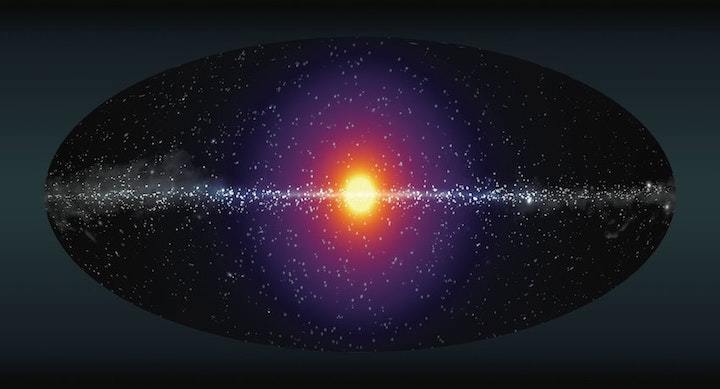27.03.2020

Decaying dark matter should produce a bright and spherical halo of X-ray emission around the centre of the Milky Way that could be detectable when looking in otherwise-blank regions of the galaxy.
US researchers say we can rule out dark matter being responsible for mysterious electromagnetic signals previously observed from nearby galaxies.
There were high hopes these signals would provide hard evidence to help identify dark matter, but new work by a team from the University of Michigan (UM), Lawrence Berkeley National Laboratory and the University of California, Berkeley, suggests otherwise.
Dark matter can't be observed directly because it does not absorb, reflect or emit light, but we know it exists because of the effect it has on other matter. Physicists have suggested dark matter is a closely related cousin of the neutrino, called the sterile neutrino.
Neutrinos – subatomic particles with no charge and which rarely interact with matter – are released during nuclear reactions inside the Sun. They have a tiny amount of mass, but this isn't explained by the Standard Model of Particle Physics.
Physicists suggest the sterile neutrino, a hypothetical particle, could account for this mass and also be dark matter.
Researchers should be able to detect the sterile neutrino because it is unstable and decays into ordinary neutrinos and electromagnetic radiation, says UM’s Ben Safdi, co-author of a paper now available on the preprint server arXiv.
To detect dark matter, physicists scan galaxies to hunt for this electromagnetic radiation in the form of X-ray emission. In 2014, researchers discovered excess X-ray emission from nearby galaxies and galaxy clusters which, Safdi says, appeared to be consistent with that which would arise from decaying sterile neutrino dark matter.
But he and his colleagues say their meta-analysis of raw data taken by the XMM-Newton space X-ray telescope of objects in the Milky Way over 20 years found no evidence that the sterile neutrino is what comprises dark matter.
"This 2014 paper and follow-up works confirmed the signal generated a significant amount of interest in the astrophysics and particle physics communities because of the possibility of knowing, for the first time, precisely what dark matter is at a microscopic level," Safdi says.
"Our finding does not mean that the dark matter is not a sterile neutrino, but it means that – contrary to what was claimed in 2014 – there is no experimental evidence to-date that points towards its existence."
Dark matter hunters search for a faint electromagnetic radiation in the form of X-ray signals. The 2014 paper named the X-ray emission the 3.5 keV line (keV for kilo-electronvolts) because of where the signal appeared on X-ray detectors.
In the new work, the research team looked at data from the "darkest" part of the Milky Way, which Safdi says significantly improved the sensitivity of previous analyses.
Co-author Christopher Dessert, also from UM, says galaxy clusters where the 3.5 keV line have been observed have large background signals, which serve as noise in observations and can make it difficult to pinpoint specific signals that may be associated with dark matter.
"The reason why we're looking through the galactic dark matter halo of our Milky Way galaxy is that the background is much lower," Dessert said.
The bottom line, the researchers say, is that if sterile neutrinos were dark matter, and if their decay led to an emission of the 3.5 keV line, they should have observed that line in their analysis. But they found no evidence for sterile neutrino dark matter.
Quelle: COSMOS
